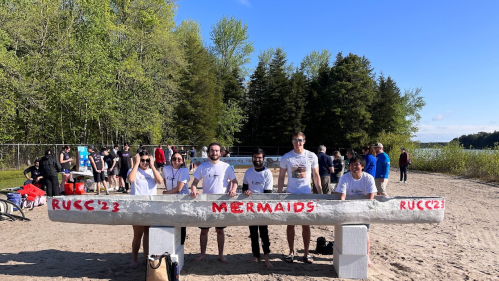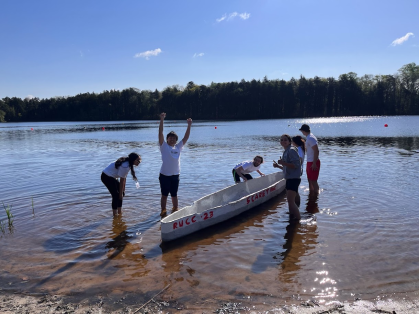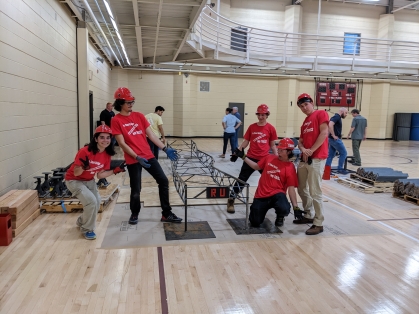Engineers Just Want to Have Fun: ASCE Concrete Canoe and Steel Bridge Competitions

For Rutgers Engineering students, competing in the annual American Society of Civil Engineers (ASCE) Concrete Canoe and Student Steel Bridge Competitions (SSBC) is a time-honored way to have a great time while sharpening engineering and project management skills.
ASCE Concrete Canoe Competition team members gain hands-on experience with concrete mix designs and project management, while the Student Steel Bridge Competition puts students’ classroom knowledge to the test with a hands-on steel-design project.
“The America’s Cup of Civil Engineering”
This year’s elite competition, known as the “America’s Cup of Civil Engineering” for its mix of engineering, design, and racing skills will be held from April 12-14 at Stony Brook University, with racing likely scheduled for the last day.

“Each school is only allowed one entry per student chapter,” explains Rutgers ASCE student chapter president and 2023 team captain Aneesh Kakirde, who passed the 2024 team captainship to seasoned team member Georges Micera. “Typically, we compete against 8 to 10 schools, and the competition is supposed to mimic an actual project. So far this year, we have around 7 team members.” This year’s team will be captained by
The teams must follow ASCE guidelines for canoe size, allowable materials, and more. “We’re

also required to submit cost estimates, that list everything from the cost of materials and labor to even the cost of using outside consultants,” Kakirde says.
The canoes must complete five courses and slaloms, and each team is judged on four categories: project proposal, technical prototype, final product prototype, and race demonstrations, according to Kakirde.
A Rewarding Challenge
The Concrete Canoe Competition is a rewarding challenge. “I’ve been involved with the team since sophomore year, and have met so many great, hard-working people,” Kakirde recalls. ”I’ve learned important skills like time management, project management, and workmanship.
“It’s definitely a great project to get involved in. Of course, the most fun comes on competition day, when we get to race our final canoe.”
Students of Steel
On April 13, the 18 members of the Rutgers steel bridge team will also compete at Stony Brook University in the ASCE and partner American Institute of Steel Construction’s (AISC) regional competition during the ASCE Student Symposia. Eligible qualifying teams will then move on to the national competition, which will be held at Louisiana Tech University from May 31 to June 1, 2024.

“I love the hands-on nature of SSBC, where I can have a part in designing a bridge and then bringing it to the real world by cutting steel, drilling holes, and welding pieces together.” says Rutgers team captain senior Andrew Hoefele, who is competing this year for the third time. “It’s also a great environment to share ideas, engage with the engineering process, and become a better leader.”
“The competition starts with construction,” says Hoefele “Each team starts with their bridge in many separate pieces, then assembles their bridge with nuts and bults as fast as they can. The teams must build their bridges under timed construction conditions at the competition itself. The bridges are judged by load-testing, weight, and aesthetic design.
“The scale-model 20-foot bridge is then inspected, weighed, and loaded with 2,500 pounds,” he adds.
According to the competition rules, a number of factors are scored, such as build time, number of builders, bridge weight, ad deflection under load, and aesthetics. “The rules and scoring are meant to mimic real-world design and construction, where factors like material cost, site conditions, and labor need to be balanced,” he explains.
“Rutgers has participated in the competitions every year since at least 2009,” he reports. “It’s a great opportunity for students to gain hands-on experience and develop their problem-solving skills,” he reports. “Since Covid, we’ve been making a lot of progress, so we have a great chance at this year’s competition.”
Get Involved! Both Hoefele and Kakirde invite students to join their teams. To learn more about how to join the Steel Bridge Competition team, contact Andrew Hoefele at amh397@scarletmail.rutgers.edu. To learn more about the Concrete Canoe team, email Aneesh Kakirde at ruconcretecanoe@gmail.com.


